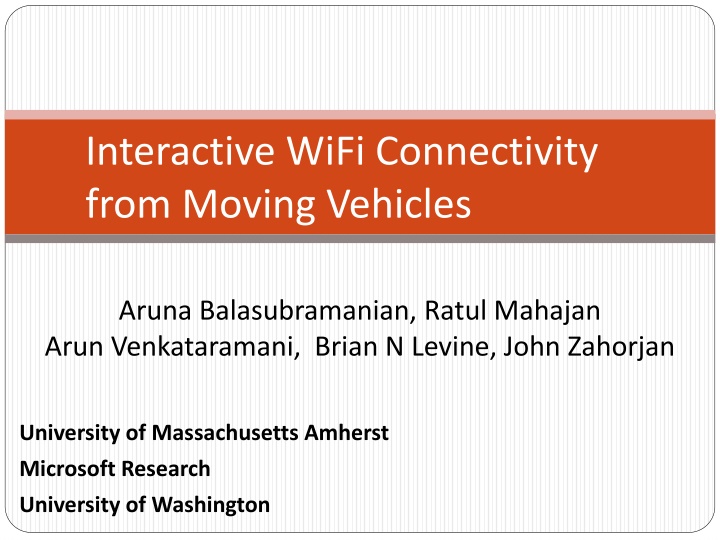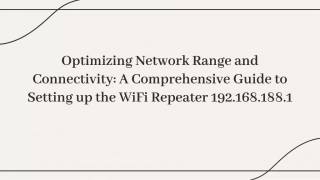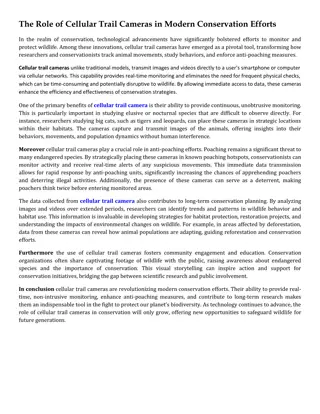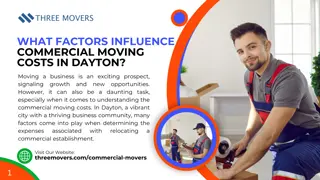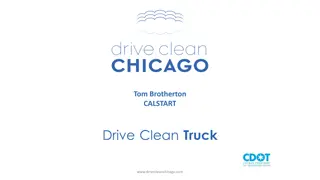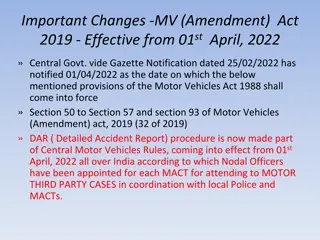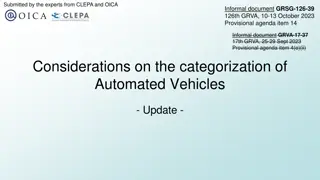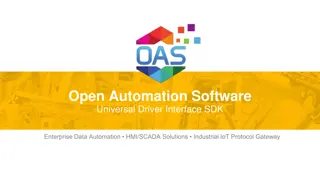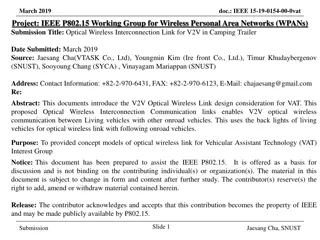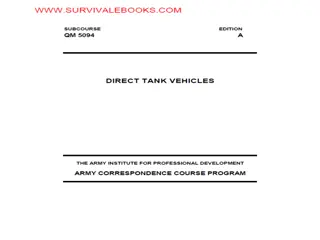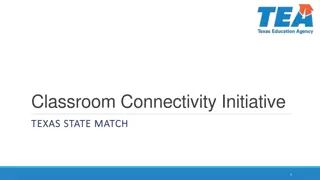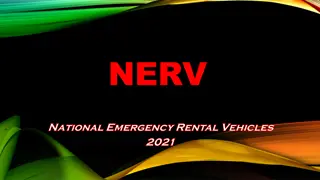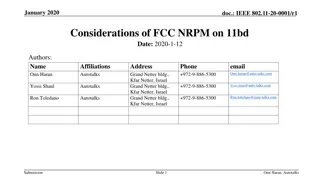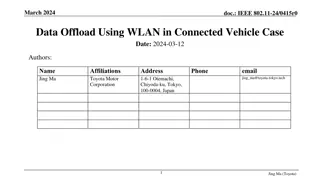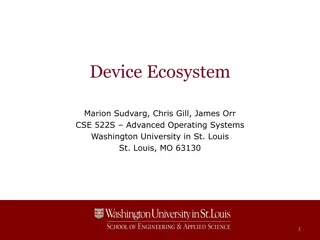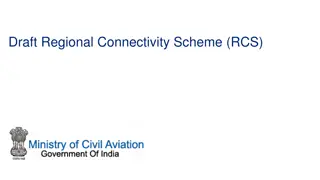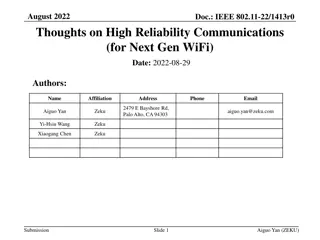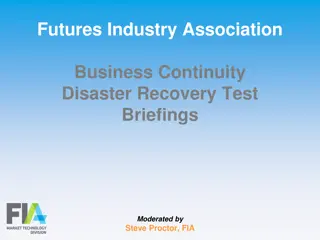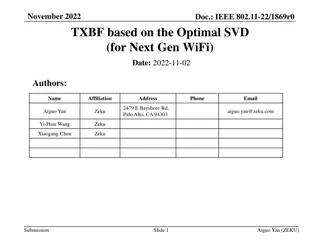Enhancing WiFi Connectivity for Moving Vehicles
This research explores the feasibility of using WiFi technology to enable network access from moving vehicles, focusing on improving performance for mainstream applications. The study includes a measurement analysis in a vehicular WiFi setting, comparing different handoff policies to enhance application performance. The findings emphasize a new handoff protocol, ViFi, as a promising solution to reduce disruptions and improve connectivity. The VanLAN vehicular testbed is utilized for practical experimentation and evaluation.
Download Presentation

Please find below an Image/Link to download the presentation.
The content on the website is provided AS IS for your information and personal use only. It may not be sold, licensed, or shared on other websites without obtaining consent from the author.If you encounter any issues during the download, it is possible that the publisher has removed the file from their server.
You are allowed to download the files provided on this website for personal or commercial use, subject to the condition that they are used lawfully. All files are the property of their respective owners.
The content on the website is provided AS IS for your information and personal use only. It may not be sold, licensed, or shared on other websites without obtaining consent from the author.
E N D
Presentation Transcript
Interactive WiFi Connectivity from Moving Vehicles Aruna Balasubramanian, Ratul Mahajan Arun Venkataramani, Brian N Levine, John Zahorjan University of Massachusetts Amherst Microsoft Research University of Washington
Motivation Increasing demand for network access from vehicles E.g., VoIP, Web, email Cellular access expensive Ubiquity of WiFi Cheaper, higher peak throughput compared to cellular 2
Our work Given enough coverage, can WiFi technology be used to access mainstream applications from vehicles? Existing work shows the feasibility of WiFi access at vehicular speeds focus on non-interactive applications. e.g., road monitoring Internet 3
Talk outline Can popular applications be supported using vehicular WiFi today? Performance is poor due to frequent disruptions How can we improve application performance? ViFi, a new handoff protocol that significantly reduces disruptions Does ViFi really improve application performance? VoIP, short TCP transfers 4
VanLAN: Our Vehicular Testbed Uses MS campus vans Base stations(BSes) are deployed on roadside buildings Currently 2 vans, 11 BSes 5
Measurement study Study application performance in vehicular WiFi setting Focus on basic connectivity Study performance of different handoff policies Trace-driven analysis Nodes send periodic packets and log receptions 6
Handoff policies studied Practical hard handoff Associate with one BS Current 802.11 Ideal hard handoff Use future knowledge Impractical 7
Handoff policies studied Practical hard handoff Associate with one BS Current 802.11 Ideal hard handoff Use future knowledge Impractical Ideal soft handoff Use all BSes in range Performance upper bound 8
Comparison of handoff policies Disruption Summary Performance of interactive applications poor when using existing handoff policies Soft handoff policy can decrease disruptions and improve performance of interactive applications Practical hard handoff Ideal hard handoff Ideal soft handoff 9
Talk outline Can popular applications be accessed using vehicular WiFi? How can we improve application performance? ViFi, a practical diversity-based handoff protocol Does ViFi really improve application performance? VoIP, short TCP transfers 10
Designing a practical soft handoff policy Goal: Leverage multiple BSes in range Not straightforward Constraints in Vehicular WiFi 1. Inter-BS backplane often bandwidth-constrained 2. Interactive applications require timely delivery 3. Fine-grained scheduling of packets difficult Internet 11
Why are existing solutions inadequate? Opportunistic protocols for WiFi mesh (ExOR, MORE) Uses batching: Not suitable for interactive applications Path diversity protocols for enterprise WLANs (Divert) Assumes BSes are connected through a high speed back plane Soft handoff protocols for cellular (CDMA-based) Packet scheduling at fine time scales Signals can be combined 12
ViFi protocol set up Vehicle chooses anchor BS Anchor responsible for vehicle s packets C A B Vehicle chooses a set of BSes in range to be auxiliaries e.g., B, C and D can be chosen as auxiliaries ViFi leverages packets overheard by the auxiliary D Internet 13
ViFi protocol C Source (1) Source transmits a packet B A (2) If destination receives, it transmits an ack Dest D (3) If auxiliary overhears packet but not ack, it probabilistically relays to destination Downstream: Anchor to vehicle C Dest (4) If destination received relay, it transmits an ack A B Source D (5) If no ack within retransmission interval, source retransmits Upstream: Vehicle to anchor 14
Why relaying is effective? Losses are bursty Independence Losses from different senders independent Losses at different receivers independent C C A B A B D D Downstream Upstream 15
Guidelines for probability computation 1. Make a collective relaying decision and limit the total number of relays 2. Give preference to auxiliary with good connectivity with destination How to make a collective decision without per-packet coordination overhead? 16
Determine the relaying probability Goal: Compute relaying probability RB of auxiliary B Step 1: The probability that auxiliary B is considering relaying CB = P(B heard the packet) . P(B did not hear ack) Step 2: The expected number of relays by B is E(B) = CB RB ViFi: Practical soft handoff protocol uses probabilistic relaying for coordination without per-packet coordination cost Step 3: Formulate ViFi probability equation, E(x) = 1, x 2 auxiliary to solve uniquely, set RB proportional to P(destination hears B) Step 4: B estimates P(auxiliary considering relaying) and P(destination heard auxiliary) for each auxiliary 17
ViFi Implementation Implemented ViFi in windows operating system Use broadcast transmission at the MAC layer No rate adaptation Deployed ViFi on VanLAN BSes and vehicles 18
Talk outline Can popular applications be accessed using vehicular WiFi? Due to frequent disruptions, performance is poor How can we improve application performance? ViFi, a practical diversity-based soft handoff protocol Does ViFi really improve application performance? 19
Evaluation Evaluation based on VanLAN deployment ViFi reduces disruptions ViFi improves application performance ViFi s probabilistic relaying is efficient Also in the paper: Trace-driven evaluation on DieselNet testbed at UMass, Amherst Results qualitatively consistent 20
ViFi reduces disruptions in our deployment ViFi Practical hard handoff 21
ViFi improves VoIP performance Use G.729 codec 100 80 60 > 100% seconds ViFi Practical hard handoff 40 20 0 0.5 Length of voice call before disruption Disruption = When mean opinion score (mos) is lower than a threshold 22
ViFi improves performance of short TCP transfers Workload: repeatedly download/upload 10KB files 100 1 80 0.8 > 50% 0.6 > 100% 60 ViFi 0.4 40 Practical hard handoff 0.2 20 0 0 Number of transfers before disruption Disruption = lack of progress for 10 seconds Median transfer time (sec) 0.5 0.5 23
ViFi uses medium efficiently Efficiency: Number of unique packets delivered/ Number of packets sent 1 0.8 efficiency 0.6 ViFi 0.4 Practical hard handoff 0.2 0 0.5 24
Conclusions Our work improves performance of interactive applications for vehicular WiFi networks Interactive applications perform poorly in vehicular settings due to frequent disruptions ViFi, a diversity-based handoff protocol significantly reduces disruptions Experiments on VanLAN shows that ViFi significantly improves performance of VoIP and short TCP transfers http://research.microsoft.com/netres/Projects/vanLAN/ 25
Practical soft handoff AllBS itself is not a practical protocol How does diversity even work in the downstream? Internet 26
Distributed computation B needs to compute for each auxiliary (1) contending probabilities (2) P(V will hear from the auxiliary) Can be computed using loss rates between the auxiliary and its neighbors Compute loss rates using beacon receptions C V Embeds its loss rates in beacons A B Learns loss rates of auxiliaries from their beacons D Estimates relaying probability of B, C and D 27
Distributed probability computation Compute consistent relaying probabilities B need to know for C and D 1. Probability that C and D are making a relaying decision 2. Probability that vehicle will hear from C and D C V A B Both can be estimated using loss probabilities between C and D and their neighbors D Nodes exchange 2-hop loss rates using beacons Compute consistent relaying probabilities B computes relaying probabilities for B, C and D 28
